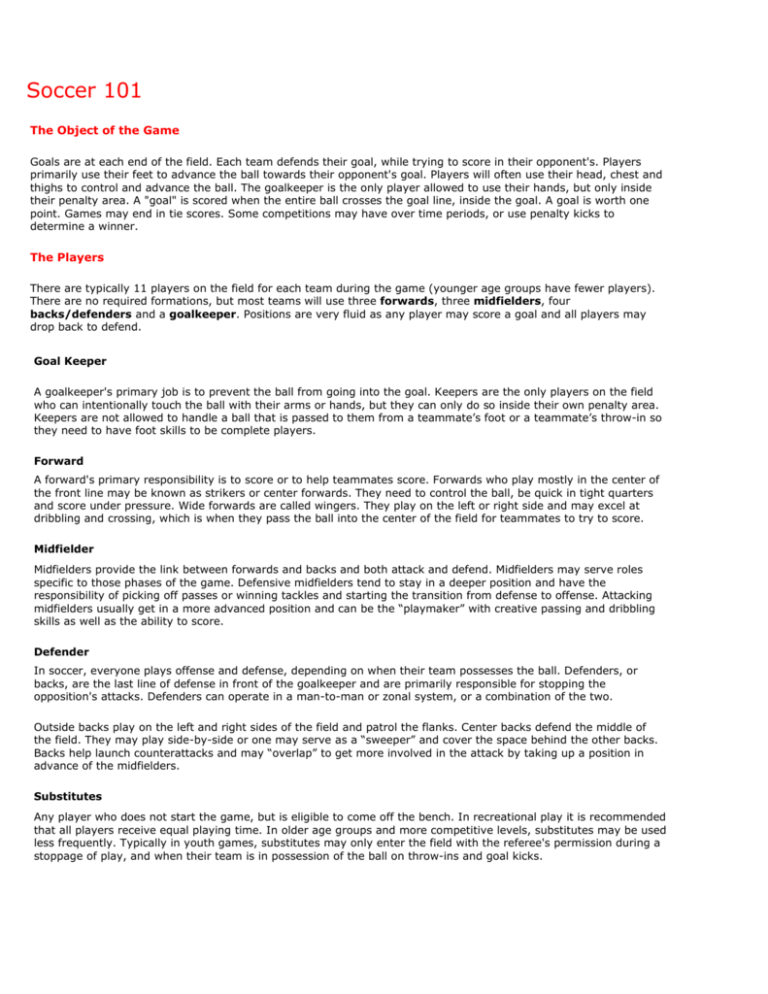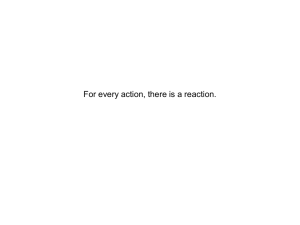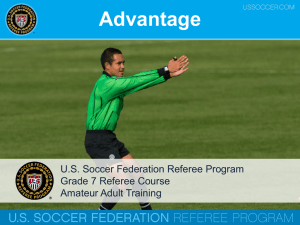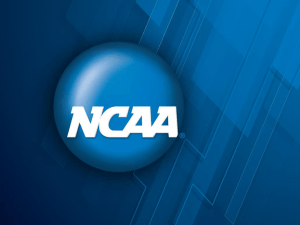Soccer 101 - US Youth Soccer
advertisement

Soccer 101 The Object of the Game Goals are at each end of the field. Each team defends their goal, while trying to score in their opponent's. Players primarily use their feet to advance the ball towards their opponent's goal. Players will often use their head, chest and thighs to control and advance the ball. The goalkeeper is the only player allowed to use their hands, but only inside their penalty area. A "goal" is scored when the entire ball crosses the goal line, inside the goal. A goal is worth one point. Games may end in tie scores. Some competitions may have over time periods, or use penalty kicks to determine a winner. The Players There are typically 11 players on the field for each team during the game (younger age groups have fewer players). There are no required formations, but most teams will use three forwards, three midfielders, four backs/defenders and a goalkeeper. Positions are very fluid as any player may score a goal and all players may drop back to defend. Goal Keeper A goalkeeper's primary job is to prevent the ball from going into the goal. Keepers are the only players on the field who can intentionally touch the ball with their arms or hands, but they can only do so inside their own penalty area. Keepers are not allowed to handle a ball that is passed to them from a teammate’s foot or a teammate’s throw-in so they need to have foot skills to be complete players. Forward A forward's primary responsibility is to score or to help teammates score. Forwards who play mostly in the center of the front line may be known as strikers or center forwards. They need to control the ball, be quick in tight quarters and score under pressure. Wide forwards are called wingers. They play on the left or right side and may excel at dribbling and crossing, which is when they pass the ball into the center of the field for teammates to try to score. Midfielder Midfielders provide the link between forwards and backs and both attack and defend. Midfielders may serve roles specific to those phases of the game. Defensive midfielders tend to stay in a deeper position and have the responsibility of picking off passes or winning tackles and starting the transition from defense to offense. Attacking midfielders usually get in a more advanced position and can be the “playmaker” with creative passing and dribbling skills as well as the ability to score. Defender In soccer, everyone plays offense and defense, depending on when their team possesses the ball. Defenders, or backs, are the last line of defense in front of the goalkeeper and are primarily responsible for stopping the opposition's attacks. Defenders can operate in a man-to-man or zonal system, or a combination of the two. Outside backs play on the left and right sides of the field and patrol the flanks. Center backs defend the middle of the field. They may play side-by-side or one may serve as a “sweeper” and cover the space behind the other backs. Backs help launch counterattacks and may “overlap” to get more involved in the attack by taking up a position in advance of the midfielders. Substitutes Any player who does not start the game, but is eligible to come off the bench. In recreational play it is recommended that all players receive equal playing time. In older age groups and more competitive levels, substitutes may be used less frequently. Typically in youth games, substitutes may only enter the field with the referee's permission during a stoppage of play, and when their team is in possession of the ball on throw-ins and goal kicks. The Field Note: Click on field to show positions (Red is in a 3-5-2 formation and Blue is in a 4-4-2 formation.). Double-click to restore. Soccer Talk Advantage: A referee can decide NOT TO STOP PLAY Half-Volley: A kick of the ball just as it is rebounding off even if there is a foul committed or misconduct, if doing the ground. so will allow the fouled team to maintain an advantage— in other words, if stopping play to penalize the foul would actually benefit the team that committed it. Beat: To get the ball around an opponent by dribbling or shooting. Header: When a player controls or strikes a ball in the air using their head. View Video Breakaway: When an attacker with the ball makes it past the last defender and is on his/her way toward the goal for a one-on one showdown with the goalkeeper. Juggling: Keeping the ball in the air with any part of the body (no hands or arms). Used for practice and developing coordination. View Video Clearing: Happens when team kicks the ball out of its defensive zone, ending an offensive threat by the opposing team. Marking: Closely defending a player to prevent him/her from receiving the ball or advancing the ball by dribbling or passing. Cross: A kick made near the sideline toward the middle Penalty Area: Rectangular area extending 18 yards from of the field to get the ball closer to the front of the goal. the goal line (modified for small-sided games). Goalkeepers only can use their hands within their own penalty area. Any foul by the defending team resulting in a direct kick inside this area results in a penalty kick for the attacking team. Corner Arcs: A quarter-circle located at each of the four corners of the field. On a corner kick, the ball must be kicked from inside this arc. Receiving: When a player uses his/her body to slow down and control a moving ball. Most often this is done using the chest, thigh or foot. View Video Chip: A short, lofted pass or shot. View Video Slide Tackle: An attempt by an opponent, usually a defender, to take the ball away from a dribbler by sliding on the ground feet first into the ball. Dribbling: The basic skill of advancing the ball with the feet while controlling it. View Video Tackle: A move to take the ball away from an opponent's feet. View Video Drop Ball: The method used to restart play after the game has been stopped for some reason not specifically covered by the rules (i.e. injuries, outside interference, dangerous weather). Throw-in: The only time a field player may use their hands. Used to bring the ball back in play after it has crossed out of bounds on the sidelines. Two hands must be used and the ball must be thrown from behind the player's head. Both feet must be on the ground and on or behind the sideline. The referee drops the ball between two players, where it was last in play or at the nearest point outside the penalty area, and may only be played once it has touched the ground. Goal Area: A rectangle area extending from the goal line. Used to designate where goal kicks are taken. Volley: A kick made while the ball is in the air, before it touches the ground. Can be for a clearance or to shoot on goal. Hat Trick: Three or more goals scored in a game by a single player. Wall: Players stand as a line or wall to protect the goal against a free kick. Kick-Off Hover over the field with your mouse and see if you can find where the following kicks take place. Kick-Off: Kick-off takes place at the center of the field and is used to start play at the beginning of a game, after halftime, or after a goal is scored. A goal can be scored directly from a kick-off. Corner Kick: Awarded to the attacking team if the defense knocks the ball out of bounds over their own endline. The kick is taken from the corner nearest where the ball went out of bounds. A goal can be scored directly from a corner kick. Goal Kick: Awarded to the defense when the attacking team knocks the ball out of bounds over the end line. The kick is taken from within the goal area, and must clear the penalty area before being touched by another player. Extremely rare and unlikely, but a goal can be scored directly from a goal kick. Penalty Kick: A penalty kick is awarded to the attacking team when a major foul is committed by a defender inside his/her own penalty area. The kick is taken from the penalty spot. Only the kicker and the keeper are allowed in the penalty area. The goalkeeper must be on the goal line until the ball is kicked. CLICK HERE to see a penalty kick in action. Free Kick: Awarded by the referee due to an infraction of the rules. The kick is generally taken from the spot in which the infraction took place. The defending team must be a minimum of 10 yards away from the ball (modified for small-sided games). There are two kinds of free kicks (direct and indirect), determined by the severity of the infraction. Direct Kick: Awarded when a serious foul is committed against another player. This is a free kick in which a goal can be scored directly by the kicker. Some fouls resulting in a direct kick are holding, striking, tripping, pushing and hand balls. CLICK HERE to see a direct kick in action. Indirect Kick: Awarded when an infraction of the rules has taken place or a less serious foul has been committed. On an indirect kick, a goal cannot be scored unless the ball is touched by a second player. Some minor fouls or infractions resulting in an indirect kick are offside and dangerous play. CLICK HERE to see an indirect kick in action. Referee Talk Charge: A player uses his or her shoulder to “bump” an opponent in an attempt to win control of the ball. This contact is legal if it is safe in the opinion of the referee (typically shoulder-to-shoulder with moderate force) and occurs while both players are near the ball. It is illegal if it is unsafe (the point of contact is the opponent’s back or chest or the player uses excessive force) or if the opponent is not near the ball. Hand Ball: Officially called handling, this is a direct free kick foul in which a player deliberately touches the ball with the hand or arm. It does not apply to goalkeepers within their own penalty areas. Officials: The referee has full authority to enforce the rules in a manner that ensures a safe, fair, and enjoyable contest. The referee is on the field with the players and keeps the official time. In Under 11 and older matches, two assistant referees may help the referee from their positions just outside the touchlines (side boundaries). Also called ARs, they may signal with flags to let the referee know when the ball leaves the field, when a player may be penalized for offside, and when they have observed fouls. The referee makes the final decision whether or not to blow the whistle and stop play. Offside: Does not apply in Under 10 and younger small-sided matches. An attacking player is in an offside position if he or she is nearer to the opposing team’s goal line than both the ball and the secondto-last opponent. It is not illegal merely to be in an offside position. A player in an offside position is penalized only if, in the opinion of the referee, he or she interferes with play, interferes with an opponent, or gains an advantage by being in that position. An offside violation is judged at the moment when a teammate plays the ball, not when the player in an offside position receives the ball or otherwise becomes involved in active play. Red Card: Displayed by the referee when he or she sends off (ejects) a player for serious misconduct. The team may not replace this player and must play shorthanded for the remainder of the game. Yellow Card: Displayed by the referee when he or she cautions (issues a formal warning to) a player for misconduct that does not merit immediate ejection. The referee sends off (red card) any player who receives two cautions (yellow cards) in the same match. Heading Guidelines These guidelines emerged from parents and coaches who had questions regarding appropriate training for heading. While heading activities were available to coaches, no resources existed to take a coach or parent through the ages and stages of development. This document, refined by several prominent coaching directors and a medical professional, proposes a systematic and progressive plan to teach heading so that performance can be improved and the risk of a bad experience or injury diminished. Guidelines for Coaching Heading in Soccer Understanding Soccer Law 11: Offside Here is an interactive guide to help better understand Soccer Law 11 — Offside. www.dynamic-thought.com/offside.swf Parent-Coach Communication





